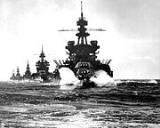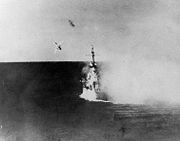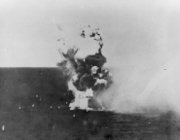
Invasion of Lingayen Gulf
Encyclopedia
The Liberation of Lingayen Gulf was an Allied
amphibious operation
in the Philippines
during World War II
. In the early morning of 9 January 1945, an Allied
force commanded by Admiral Jesse B. Oldendorf
began approaching the shores of Lingayen
. U.S. Navy
and Royal Australian Navy
warships began bombarding suspected Japanese
positions along the coast of Lingayen
from their position in Lingayen Gulf
.
, the Lingayen Gulf proved a strategically important theater of war between American and Japanese forces. On 22 December 1941, the Japanese 14th Army—under Lieutenant General Masaharu Homma
—landed on the Eastern part of the gulf at Agoo, Caba, Santiago and Bauang, where they engaged in a number of relatively minor skirmishes with the defenders, which consisted of a poorly-equipped contingent of predominantly American
and Filipino
troops, and managed to successfully invade and occupy the gulf. Following the defeat, the next day General Douglas MacArthur
issued the order to retreat from Luzon
and withdraw to Bataan
. For the next three years, the gulf remained under Japanese occupation prior to the Lingayen Gulf Landings.


s attacking on the 7th. On the 8th, it was observed that in the town of Lingayen
, as a response to the pre-landing bombardment, Filipinos had begun to form a parade
, complete with United States and Philippine flags; fire was shifted away from that area.
At 09:30 on 9 January 1945, about 68,000 men under General Walter Krueger
of the U.S. 6th Army
—following a devastating naval bombardment—landed at the coast of Lingayen Gulf
meeting no opposition. A total of 203,608 were eventually landed over the next few days, establishing a 20 mi (32.2 km) beachhead, stretching from Sual, Lingayen and Dagupan (XIV Corps) to the west, and San Fabian (I Corps) in to the east. The total number of troops under the command of MacArthur was reported to have even exceeded the number that Dwight D. Eisenhower
controlled in Europe. Within a few days, the assault forces had quickly captured the coastal towns and secured the 20-mile long beach, including the town of San Fabian
.
Despite their success in driving out the Japanese army stationed there, they suffered relatively heavy losses, particularly to their convoys, due to kamikaze
attacks. From 4-12 January, a total of 24 ships were sunk and 67 damaged by kamikazes, including the battleship
s and (the latter was accidentally hit by friendly fire), the heavy cruiser
, the light cruiser
, and the destroyer
s and . Following the landings, the Lingayen Gulf was turned into a vast supply depot for the rest of the war to support the Battle of Luzon
.
Veterans’ Day. In the 63rd anniversary commemoration of the Lingayen Gulf
Landing, President Fidel Ramos appealed to U.S. President George W. Bush
for 24,000 surviving war veterans, to pass 2 legislative bills pending since 1968 at the US House of Representatives — the Filipino Veterans’ Equity Act of 2006 and the Filipino Veterans’ Equity of 2005 sponsored by former Senator Daniel Inouye
.
Allies of World War II
The Allies of World War II were the countries that opposed the Axis powers during the Second World War . Former Axis states contributing to the Allied victory are not considered Allied states...
amphibious operation
Amphibious warfare
Amphibious warfare is the use of naval firepower, logistics and strategy to project military power ashore. In previous eras it stood as the primary method of delivering troops to non-contiguous enemy-held terrain...
in the Philippines
Commonwealth of the Philippines
The Commonwealth of the Philippines was a designation of the Philippines from 1935 to 1946 when the country was a commonwealth of the United States. The Commonwealth was created by the Tydings-McDuffie Act, which was passed by the U.S. Congress in 1934. When Manuel L...
during World War II
World War II
World War II, or the Second World War , was a global conflict lasting from 1939 to 1945, involving most of the world's nations—including all of the great powers—eventually forming two opposing military alliances: the Allies and the Axis...
. In the early morning of 9 January 1945, an Allied
Allies of World War II
The Allies of World War II were the countries that opposed the Axis powers during the Second World War . Former Axis states contributing to the Allied victory are not considered Allied states...
force commanded by Admiral Jesse B. Oldendorf
Jesse B. Oldendorf
Jesse Bartlett "Oley" Oldendorf was an admiral in the United States Navy, famous for defeating a Japanese force in the Battle of Leyte Gulf during World War II...
began approaching the shores of Lingayen
Lingayen, Pangasinan
Lingayen is a 1st class municipality in the province of Pangasinan on the island of Luzon in the Philippines. It is the capital municipality and the seat of government of the province of Pangasinan. According to the latest census, it has a population of 95,773 people in 16,467 households.Lingayen...
. U.S. Navy
United States Navy
The United States Navy is the naval warfare service branch of the United States Armed Forces and one of the seven uniformed services of the United States. The U.S. Navy is the largest in the world; its battle fleet tonnage is greater than that of the next 13 largest navies combined. The U.S...
and Royal Australian Navy
Royal Australian Navy
The Royal Australian Navy is the naval branch of the Australian Defence Force. Following the Federation of Australia in 1901, the ships and resources of the separate colonial navies were integrated into a national force: the Commonwealth Naval Forces...
warships began bombarding suspected Japanese
Empire of Japan
The Empire of Japan is the name of the state of Japan that existed from the Meiji Restoration on 3 January 1868 to the enactment of the post-World War II Constitution of...
positions along the coast of Lingayen
Lingayen, Pangasinan
Lingayen is a 1st class municipality in the province of Pangasinan on the island of Luzon in the Philippines. It is the capital municipality and the seat of government of the province of Pangasinan. According to the latest census, it has a population of 95,773 people in 16,467 households.Lingayen...
from their position in Lingayen Gulf
Lingayen Gulf
The Lingayen Gulf is an extension of the South China Sea on Luzon in the Philippines stretching . It is framed by the provinces of Pangasinan and La Union and sits between the Zambales Mountains and the Cordillera Central...
.
Background
During World War IIWorld War II
World War II, or the Second World War , was a global conflict lasting from 1939 to 1945, involving most of the world's nations—including all of the great powers—eventually forming two opposing military alliances: the Allies and the Axis...
, the Lingayen Gulf proved a strategically important theater of war between American and Japanese forces. On 22 December 1941, the Japanese 14th Army—under Lieutenant General Masaharu Homma
Masaharu Homma
was a general in the Imperial Japanese Army. He is noteworthy for his role in the invasion and occupation of the Philippines during World War II. Homma, who was an amateur painter and playwright, was also known as the Poet General.-Biography:...
—landed on the Eastern part of the gulf at Agoo, Caba, Santiago and Bauang, where they engaged in a number of relatively minor skirmishes with the defenders, which consisted of a poorly-equipped contingent of predominantly American
United States Army
The United States Army is the main branch of the United States Armed Forces responsible for land-based military operations. It is the largest and oldest established branch of the U.S. military, and is one of seven U.S. uniformed services...
and Filipino
Philippine Army
The Philippine Army is the ground arm of the Armed Forces of the Philippines . Its official name in Tagalog is Hukbong Katihan ng Pilipinas. On July 23, 2010, President Benigno Aquino III appointed Maj. Gen...
troops, and managed to successfully invade and occupy the gulf. Following the defeat, the next day General Douglas MacArthur
Douglas MacArthur
General of the Army Douglas MacArthur was an American general and field marshal of the Philippine Army. He was a Chief of Staff of the United States Army during the 1930s and played a prominent role in the Pacific theater during World War II. He received the Medal of Honor for his service in the...
issued the order to retreat from Luzon
Luzon
Luzon is the largest island in the Philippines. It is located in the northernmost region of the archipelago, and is also the name for one of the three primary island groups in the country centered on the Island of Luzon...
and withdraw to Bataan
Bataan
Bataan is a province of the Philippines occupying the whole of the Bataan Peninsula on Luzon. The province is part of the Central Luzon region. The capital of Bataan is Balanga City and it is bordered by the provinces of Zambales and Pampanga to the north...
. For the next three years, the gulf remained under Japanese occupation prior to the Lingayen Gulf Landings.


Operations
Beginning on 6 January 1945, preparations began which lasted until the 8th. Underwater demolitions began, but found no beach obstacles, and encountered sparse opposing forces. Aircraft and naval artillery bombardment of the landing areas also occurred, with kamikazeKamikaze
The were suicide attacks by military aviators from the Empire of Japan against Allied naval vessels in the closing stages of the Pacific campaign of World War II, designed to destroy as many warships as possible....
s attacking on the 7th. On the 8th, it was observed that in the town of Lingayen
Lingayen, Pangasinan
Lingayen is a 1st class municipality in the province of Pangasinan on the island of Luzon in the Philippines. It is the capital municipality and the seat of government of the province of Pangasinan. According to the latest census, it has a population of 95,773 people in 16,467 households.Lingayen...
, as a response to the pre-landing bombardment, Filipinos had begun to form a parade
Parade
A parade is a procession of people, usually organized along a street, often in costume, and often accompanied by marching bands, floats or sometimes large balloons. Parades are held for a wide range of reasons, but are usually celebrations of some kind...
, complete with United States and Philippine flags; fire was shifted away from that area.
At 09:30 on 9 January 1945, about 68,000 men under General Walter Krueger
Walter Krueger
Walter Krueger was an American soldier of German descent and General in the first half of the 20th century. He is best known for his command of the Sixth United States Army in the South West Pacific Area during World War II...
of the U.S. 6th Army
U.S. Sixth Army
The Sixth United States Army is a field army of the United States Army.-History:It was first activated in January 1943, commanded by Lieutenant General Walter Krueger. Under the code name Alamo Force, it assumed control of the majority of US Army units involved in Operation Cartwheel, the campaign...
—following a devastating naval bombardment—landed at the coast of Lingayen Gulf
Lingayen Gulf
The Lingayen Gulf is an extension of the South China Sea on Luzon in the Philippines stretching . It is framed by the provinces of Pangasinan and La Union and sits between the Zambales Mountains and the Cordillera Central...
meeting no opposition. A total of 203,608 were eventually landed over the next few days, establishing a 20 mi (32.2 km) beachhead, stretching from Sual, Lingayen and Dagupan (XIV Corps) to the west, and San Fabian (I Corps) in to the east. The total number of troops under the command of MacArthur was reported to have even exceeded the number that Dwight D. Eisenhower
Dwight D. Eisenhower
Dwight David "Ike" Eisenhower was the 34th President of the United States, from 1953 until 1961. He was a five-star general in the United States Army...
controlled in Europe. Within a few days, the assault forces had quickly captured the coastal towns and secured the 20-mile long beach, including the town of San Fabian
San Fabián
San Fabián is one of 21 communes in the Ñuble Province of central Chile's Biobío Region. The capital is the town of San Fabián de Alico. The commune spans an area of .-Administration:...
.
Despite their success in driving out the Japanese army stationed there, they suffered relatively heavy losses, particularly to their convoys, due to kamikaze
Kamikaze
The were suicide attacks by military aviators from the Empire of Japan against Allied naval vessels in the closing stages of the Pacific campaign of World War II, designed to destroy as many warships as possible....
attacks. From 4-12 January, a total of 24 ships were sunk and 67 damaged by kamikazes, including the battleship
Battleship
A battleship is a large armored warship with a main battery consisting of heavy caliber guns. Battleships were larger, better armed and armored than cruisers and destroyers. As the largest armed ships in a fleet, battleships were used to attain command of the sea and represented the apex of a...
s and (the latter was accidentally hit by friendly fire), the heavy cruiser
Heavy cruiser
The heavy cruiser was a type of cruiser, a naval warship designed for long range, high speed and an armament of naval guns roughly 203mm calibre . The heavy cruiser can be seen as a lineage of ship design from 1915 until 1945, although the term 'heavy cruiser' only came into formal use in 1930...
, the light cruiser
Light cruiser
A light cruiser is a type of small- or medium-sized warship. The term is a shortening of the phrase "light armored cruiser", describing a small ship that carried armor in the same way as an armored cruiser: a protective belt and deck...
, and the destroyer
Destroyer
In naval terminology, a destroyer is a fast and maneuverable yet long-endurance warship intended to escort larger vessels in a fleet, convoy or battle group and defend them against smaller, powerful, short-range attackers. Destroyers, originally called torpedo-boat destroyers in 1892, evolved from...
s and . Following the landings, the Lingayen Gulf was turned into a vast supply depot for the rest of the war to support the Battle of Luzon
Battle of Luzon
The Battle of Luzon was a land battle fought as part of the Pacific Theater of Operations of World War II by the Allied forces of the U.S., its colony The Philippines, and Mexico against forces of the Empire of Japan. The battle resulted in a U.S. and Filipino victory...
.
Commemoration
On January 9, 2008, Gov. Amado Espino, Jr. and Vice Gov. Marlyn Primicias-Agabas institutionalized the commemoration to honor the war veterans. The resolution named January 9 as PangasinanPangasinan
Pangasinan is a province of the Republic of the Philippines. The provincial capital is Lingayen. Pangasinan is located on the west central and peripheral area of the island of Luzon along the Lingayen Gulf, with the total land area being 5,368.82 square kilometers . According to the latest census,...
Veterans’ Day. In the 63rd anniversary commemoration of the Lingayen Gulf
Lingayen Gulf
The Lingayen Gulf is an extension of the South China Sea on Luzon in the Philippines stretching . It is framed by the provinces of Pangasinan and La Union and sits between the Zambales Mountains and the Cordillera Central...
Landing, President Fidel Ramos appealed to U.S. President George W. Bush
George W. Bush
George Walker Bush is an American politician who served as the 43rd President of the United States, from 2001 to 2009. Before that, he was the 46th Governor of Texas, having served from 1995 to 2000....
for 24,000 surviving war veterans, to pass 2 legislative bills pending since 1968 at the US House of Representatives — the Filipino Veterans’ Equity Act of 2006 and the Filipino Veterans’ Equity of 2005 sponsored by former Senator Daniel Inouye
Daniel Inouye
Daniel Ken "Dan" Inouye is the senior United States Senator from Hawaii, a member of the Democratic Party, and the President pro tempore of the United States Senate making him the highest-ranking Asian American politician in American history. Inouye is the chairman of the United States Senate...
.

